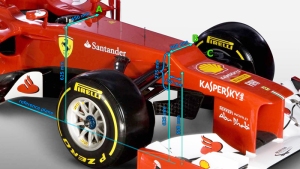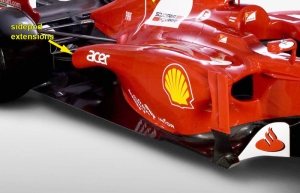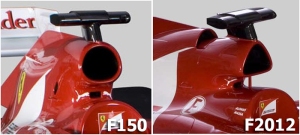 Side view comparison
Side view comparison
The F2012 , coded 663 project , looks at first glance really ugly but Ferrari what needs in 2012 is to see the ugly duckling being transformed into a swan on track . Besides Formula 1 is not a beauty contest but still a crown and glamour wait for the victorious ones . The new car is an aggressive evolution of F150o , thus only a few parts from the previous car had been carried over the new one . Therefore mechanics in technical office and in production had to work harder than usual to get the work done in time .
The team announced that an aggressive development program is followed and upgrades of components are expected for the third test and first race of season .

Front zone details
The new technical regulations for 2012 aim to lower the nose cone height for safety reasons and are responsible for the bizarre stepped nose shaping of F2012 .

The maximum dimensions allowed by 2012 technical regulations are shown above
Ferrari exploited the chassis and nose cone dimensions to the largest limit . The nose starts 450 mm wide (point A) and gets narrower where the nose box meets the chassis (point B , named also bulkhead ) , being only 300 mm wide . Then the nose drops down steeply to meet the maximum height of 550 mm at a distance of 150 mm ahead of point B . After the point C the nose becomes wider till the nose tip (easily noticed on top view image) in order to allow the maximum possible quantity of air to flow under the nose . So the goal to retain a rich flow underneath the nose box under new regulations gave birth to the stepped nose structure for 2012 which is also called by some authors “crocodile” nose . Crocodile term was also used some years ago to describe the very thin Mc Laren nose tip and thus a confusion might rise between the two designs which bear no similarity other than the name .
 Top view comparison
Top view comparison
Some other significant characteristics of the front zone are the following :
– The very wide nose pillars , inherited by F150o , help to isolate the flow directed under the nose box from the air flowing over the wing flaps which is dirtier and harder to exploit . The pillars are connected via a horizontal flap acting as a flow stabilizer , similar to the one used to connect the nose vanes in F150 .
– The nose vanes resemble a lot to the ones featured by F150 and are within 2012 regulations provided they do not extend below the reference plane set by the front wing endplates . More efficient omes similar to Renault’s R30 – 2010 might be seen at Jerez test in a few days .
– There is a small duct under the chassis to cool nose electronics and even the driver himself . Ducts in front of the cockpit are frequently used by many teams to cool the cockpit zone especially in hot conditions . Under chassis duct could be even more efficient because it receives a stronger airflow and leaves the area in front of the cockpit cleaner .
- The laser sensor to record the car’s ride height is a must on all modern F1 cars

Front wing
The front wing that will be seen on first test at Jerez is an evolution of the one introduced in the last three races of last season . It is going to be further developed at the third pre season test .
Sidepods – Radiator inlets – Exhausts

Radiators inlets resemble more to F10’s , having a quarter circle shape different from the boxy shape of F150o’s .
The sidepod tunnels are even more sculpted at their bottoms and end to a slimmer coke bodywork due to repackaging of the chassis and engine rear part , the narrower gearbox and the shifting of the hot air exits to the back ala Red Bull style .
Central body aero elements such as sidepod panels and bargeboards are also new .

Periscope style exhaust are imposed by 2012 regulations so F2012 exhaust outlets are located inside sidepod extensions to the rear and blow the rear brake duct zone. The solution brings to memory the Mc Laren MP4/14-1999 car which featured elegant holes at analogous sidepod extension to allow hot air to exit and Prost AP02-1999 which had the exhausts blow in front of the rear wheels. Different exhaust positioning scenarios are still under investigation and will for sure be over season . I predict that some solutions involving tyre heating might also rise. We should not forget Renault example a few years ago .
Engine cover

The engine cover is literally wrapped around internal components like skin , thus some bulges can be seen on the smooth surface . The large funnel at the end is gone but likely it will be seen again among other cooling options .
Airbox zone

Airbox zone is completely new . A triangular main inlet, which feeds the engine with air, replaced the previous circular to allow more air to reach the smaller inlet sitting behind. The second inlet was seen also on Mc Laren (MP4/26-2011) and Williams (FW32 2010) and feeds the gearbox radiator . The airbox zone is also sculpted further under the triangular inlet to minimize as possible the overall frontal surface .
Mirrors

The mirrors are mounted higher to block less the flow over the sidepod surface . The small triangular fin under the mirror and in front of the radiator inlet has grown in size to maximize its ability to split air over the sidepods and towards the radiator .
Suspensions

In an attempt to lower as possible the centre of gravity Ferrari changed to pull rod philosophy not only the rear suspension but for the front as well . It took Ferrari a lot of work to regain back all the desired mechanical characteristics offered by the former push rod configuration and team also believes that gained a small aerodynamic advantage out of the solution . Front pull rod configurations were seen again in F1 and particularly on Arrows and Minardi teams back in 2000 and 2001 respectively .
Wheels

The crowned front and rear thicker rims are replaced by more conventional designs .
Rear end

There is a new narrower gearbox casing and a relocation of some mechanical components . Part of the radiator cooling is hosted on top of the gearbox so as to reduce the cooling area required at the lateral part of the car .The diffuser was covered during the launch of the car to hide structure details .
KERS unit – Engine

In 2011 top teams used special engine mappings that increased engine’s fuel consumption so as to blow more hot fumes on diffuser area when cornering to gain performance even when the driver had his foot of throttle . Thus with the ban of EBD ( exhaust blown diffuser ) and FIA control over engine mapping, the 2012 engine will be more fuel efficient .
Another change is that engine was tuned in 2011 to work with very long exhaust pipes placed directly inside the floor . 2012 periscope exhaust pipes are by far shorter and so the engine had to be retuned once again , but that was not a problem because analogous periscope exhausts were raced with the same Ferrari engine back in 2009. Furthermore the current engines were once designed bearing in mind the periscope exhausts length .
The KERS components maintain their low central location in the car for safety and packaging reasons . The 2012 unit undergone an update to save weight and improve the efficiency of individual components .









0 comments:
Post a Comment